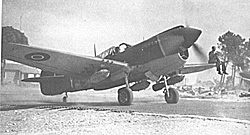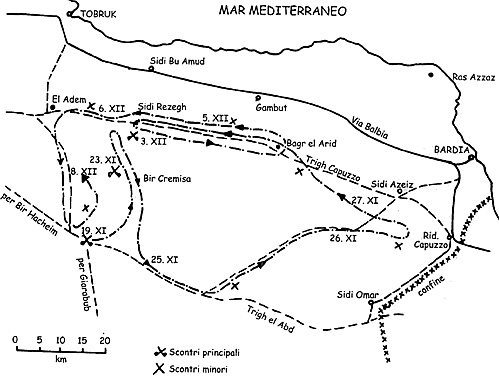 What follows is Part Two of a description of the battle fought between the Italian armored division Ariete (Ram), the best and best known Italian armored division of the whole WW2, and the British 22nd armored brigade on 19 November 1941, during Operation Crusader.
Part One, dealing with the Italians, was published in Operations 34.
What follows is Part Two of a description of the battle fought between the Italian armored division Ariete (Ram), the best and best known Italian armored division of the whole WW2, and the British 22nd armored brigade on 19 November 1941, during Operation Crusader.
Part One, dealing with the Italians, was published in Operations 34.
The British
22nd Armoured Brigade
The 22nd Brigade was activated on 3 September 1939, as part of the British Territorial Army. It was formed by the 3rd (Lt.-Colonel Jago) and 4th (Lt.-Colonel Carr) County of London Yeomanry Regiments (The Sharpshooters) and 2nd Royal Gloucestershire Hussars Regiment (Lt.-Colonel Miller). The 22nd Armoured was under the command of Brigadier J. Scott-Cockburn.
The brigade remained near London for a short time then moved to Somerset and North Devon, where it stayed until 28 December 1939.
Very little equipment was available during this period, but the men were trained in gunnery, wireless, driving and maintenance. Also, the ranks were increased by the first drafts of militiamen.
On 28 December the 22nd was incorporated in the 2nd Armoured Division (Major-General Hotblack) and moved to the Worksop area. Equipment was starting to come and the first men were trained in tank driving.
In June 1940 the brigade moved to East Anglia, on counter-invasion duty. From July to October it was in Northamptonshire and was fully equipped with Mark VI C light tanks. During October the 22nd Brigade was reassigned to 1st Armoured Division (2nd Armoured Division was leaving for the Middle East) and moved to Surrey, near Guildford. During the winter the Brigade was extensively trained, taking part in several large-scale exercises.
On January 1941 the 22nd received its first A13 tanks. The tanks' gunners were able to fire eight shots each in the Linney Head (Pembrokeshire) area.
During the spring, particular care was devoted to squadron training, but at the end of April all the tanks were taken away from the brigade and sent to Middle East. In May new equipment arrived and the 22nd moved to the Salisbury Plain area to perform intensive regimental- and brigade-level training.
During July the brigade lost all its tanks for the second time, but was soon re-equipped. On 31 July came the order to mobilize for service overseas and on 1 August the unit was inspected by the King and Queen at Warminster. The brigade was equipped with the new Mk.VI Cruiser (Crusader) tanks. It was the first brigade to be fully equipped with this tank.
At the middle of August the 22nd embarked at the Clyde, Avonmouth and Liverpool, starting the trip to Middle East. The transport ship Strathmore carried the 2nd Royal Gloucestershire Hussars, the Orion carried the Brigade HQ and 3rd CLY and the Port Jackson carried the 4th CLY. The trip was quiet, the most dangerous event happening when the battleship Revenge, with its steering gear out of order, sailed across the bow of the Orion. The damage was not very great, even though the convoy had to slow down. The ships made the longer route around all of Africa, arriving at Port Said. The last lap was made by train to El Amirya, near Alexandria.
After five more weeks of training the great news was received: the 22nd was to go into action as part of the already famous 7th Armoured Division (Major-General Gott), The Desert Rats. Also part of the 22nd Brigade were C battery/4th RHA Regiments (8 25-pdr guns) and an AT section from 102nd RHA Regiment (4 2-pdr guns). 7th Armoured Division was part of Norrie's XXX Corps, under the newly named 8th Army of Lt.-General Sir Alan Cunningham. Operation Crusader was starting.
3rd and 4th County of London Yeomanry Regiments (The Sharpshooters)
The Sharpshooters were raised initially during the Boer War, and they had been a yeomanry cavalry regiment during WW1. In common with a number of yeomanry regiments, after the war they were reduced in size and status and absorbed in the Royal Tank Corps in the reorganization of the Territorial Army which took place after the armistice.
In 1935, The Sharpshooters were no more than a small company, 120 men strong, officially known as the 23rd Armoured Car Company. During that year they took part as an unit of the 1st Cavalry Brigade in the biggest set of Army maneuvers held between WW1 and WW2. As the war approached, the Sharpshooters began to grow in size. At camp at Budleigh Salterton in 1938 they were organized in two full squadrons. Lanchester armored cars replaced the old Rolls-Royces.
After the Munich crisis, which handed over the Czechs to Hitler, the Sharpshooters were restored to regimental status, becoming the 23rd Cavalry Armoured Car Regiment. By the time they went to camp another time in 1939, the Sharpshooters were organized in two full-strength regiments. The first one took back the old title, the 3rd County of London Yeomanry, which had lapsed at the end of WW1, while the second one took the new title, 4th County of London Yeomanry.
On 1 September 1939 the two regiments were officially mobilized. Then, as part of the 22nd Armoured Brigade, they spent the next two years training in Great Britain. At the end of October 1941, they were in an open desert area southwest of Mersa Matruh.
The Sharpshooters regimental history says: 'At this point in time the Sharpshooters stood possessed of pretty nearly everything that good troops need to win wars. Their strength in officers, men and material was unpaired; confidence in themselves and in each other, begotten of efficient training intelligently digested, was at its highest; morale was at a peak; their own esprit de corps was-if that were possible-intensified by the excitement of immediately impending battle.'
The 3rd and 4th CLY Regiments were equipped with the Mk.VI Crusader I medium tank. Powered by the 340 HPs Nuffield Liberty Mk.II, the Crusader had a maximum speed of 44 km/h on road and 22 km/h on irregular terrain, and a maximum autonomous of 200 kms. It was equipped with the 2pdr gun (with a muzzle velocity of 897 meters/second) and two 7.92 Besa MGs. In November 1941 it was on equal terms with the Italian M13/40. The unit also had a small number of Crusader CS (close support), equipped with 3.7ö howitzers.
2nd Royal Gloucestershire Hussars Regiment
The 2nd RGH Regiment was formed just before the war. It spent nearly two years training with the Sharpshooters Regiments and then left Great Britain for Middle East along with them.
Then Operation Crusader started.
The regimental history says: 'Everybody was in the best of spirits and perfectly confident of being able to deal with whatever force they were asked to take on. ' The Brigade Intelligence Officer had previously given us a talk on German and Italian tanks, and he said that the only tank that might bother us was the German Mk.IV, and that there were only 20 of them in North Africa. 'We felt almost sorry for the enemy.'
The 2nd RGH Regiment was equipped along the same lines as the 3rd and 4th CLY Regiments. The Regiment was disbanded early in 1943.
More Bir el Gobi

Back to Table of Contents -- Operations #35
Back to Operations List of Issues
Back to MagWeb Master List of Magazines
© Copyright 1999 by The Gamers.
This article appears in MagWeb (Magazine Web) on the Internet World Wide Web.
Other military history articles and gaming articles are available at http://www.magweb.com